The idea for an issue of Charity stamps by the postal authority in Victoria to raise money to help fund a Hospital in Victoria was apparently suggested by Mr. F. R Godfrey who was a member of the Philatelic Society of Victoria. He wanted Victoria follow the charitable lead of New South Wales earlier in 1897.
A public competition was held immediately to obtain suggestions for possible designs. The first prize of 10 guineas (£10/10/-) was won by E. L. Howard who had been the successful designer in New Zealand's competition for the 4d., 6d. and 8d. pictorial stamps which were issued in 1898.
1897 was the year of Queen Victoria's Jubilee as she had ascended the throne at the age of 18 on the death of William IV in 1837. Consequently these stamps are often referred to as Victoria's Jubilee stamps.
The stamps were eagerly anticipated and so the Post Office expected a very high demand for the stamps despite many adverse comments like those which "welcomed" the New South Wales Consumptive Homes issue. Mail order sales for the stamps were very significant - especially for the 2½d (2/6) red-brown stamp. Consequently their supply had to be rationed. Individual stamp collectors were given precedence over dealers and the maximum number given to any one request was eight stamps.
The supply of the stamps by mail order was accompanied by a note summarising the situation for an individual. A typical note (now rated as rare) is shown below together with the stamps supplied.
 |
 |
 |
Typical correspondence associated with the 1897 Hospital Fund issue. |
 A similar advice notice to Mr. Frank Wroewould of 93 William Street, City for four 2½d (2/6) stamps (with a strip of three still adhered). |
The other recorded advice notices are:
|
In March 1898, various Press reports noted that "the sale of the stamps had realised £2,090. The Government deducted £295 face value and paid the balance to the Treasurer".
An interesting aspect of the issue is that the stamps were marked POSTAGE. In 1883 however, the Post Office allowed postage stamps to be used interchangeably with duty stamps. There is no recorded use of the Charity stamps being used as duty stamps - and it is a very unlikely possibility anyway.